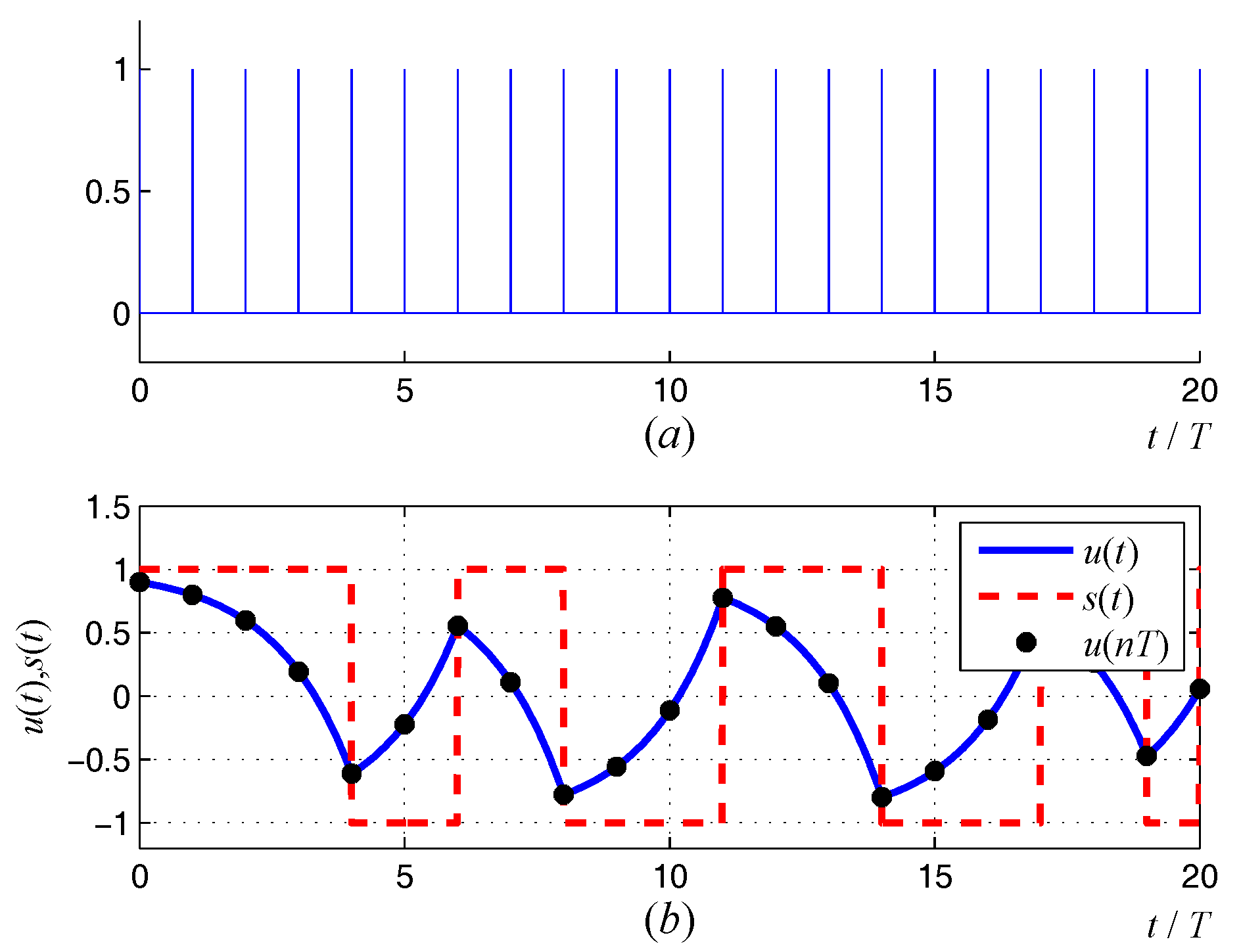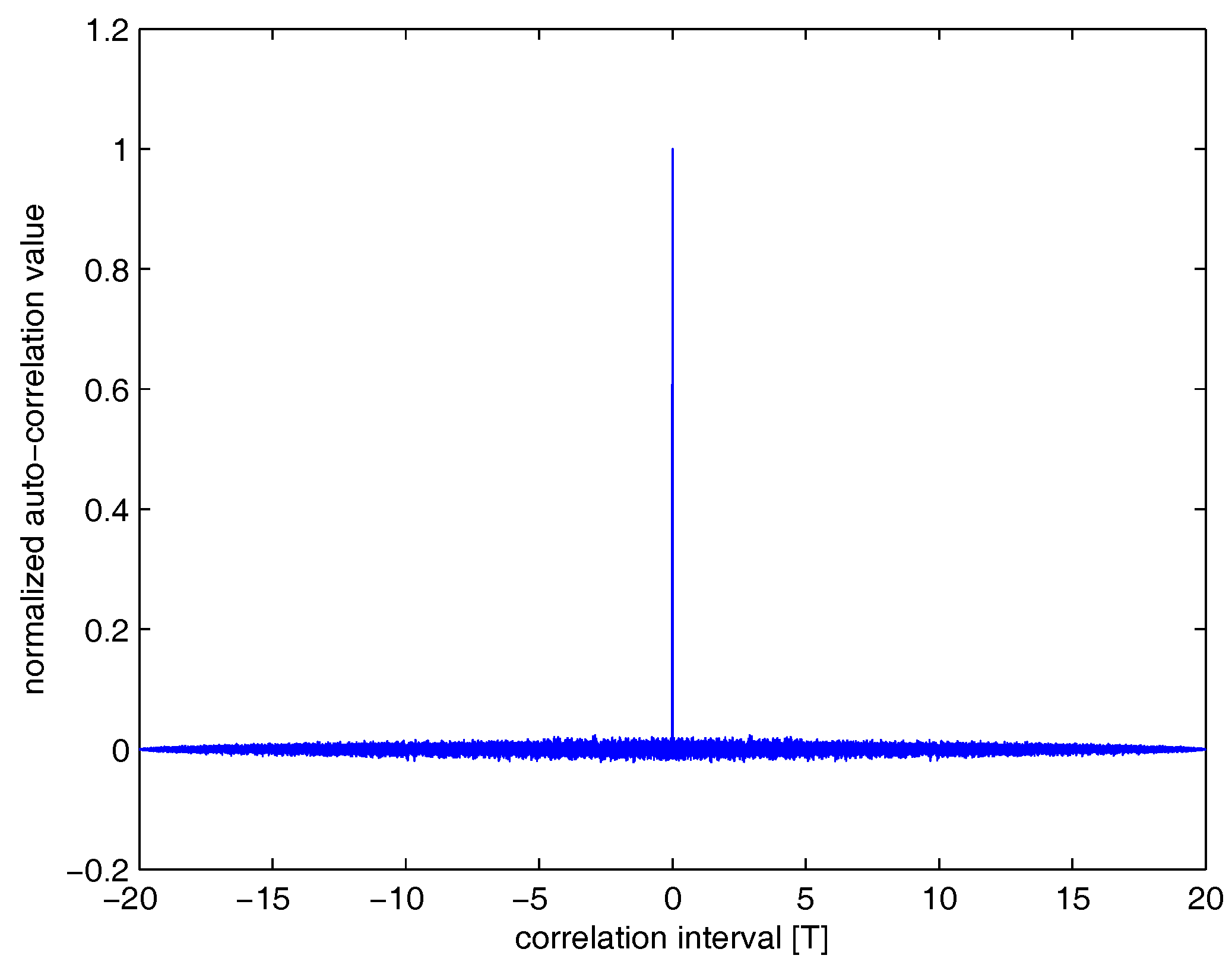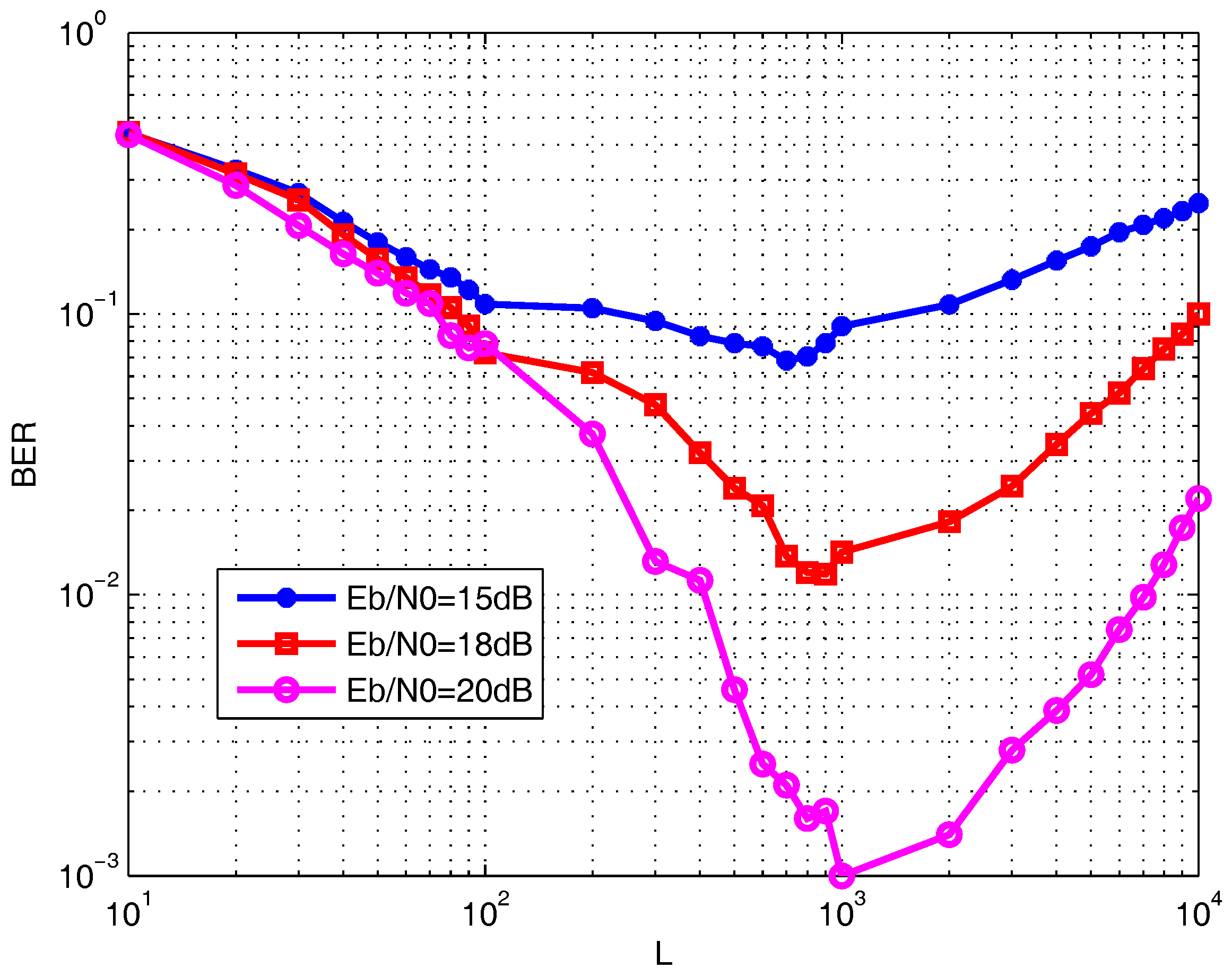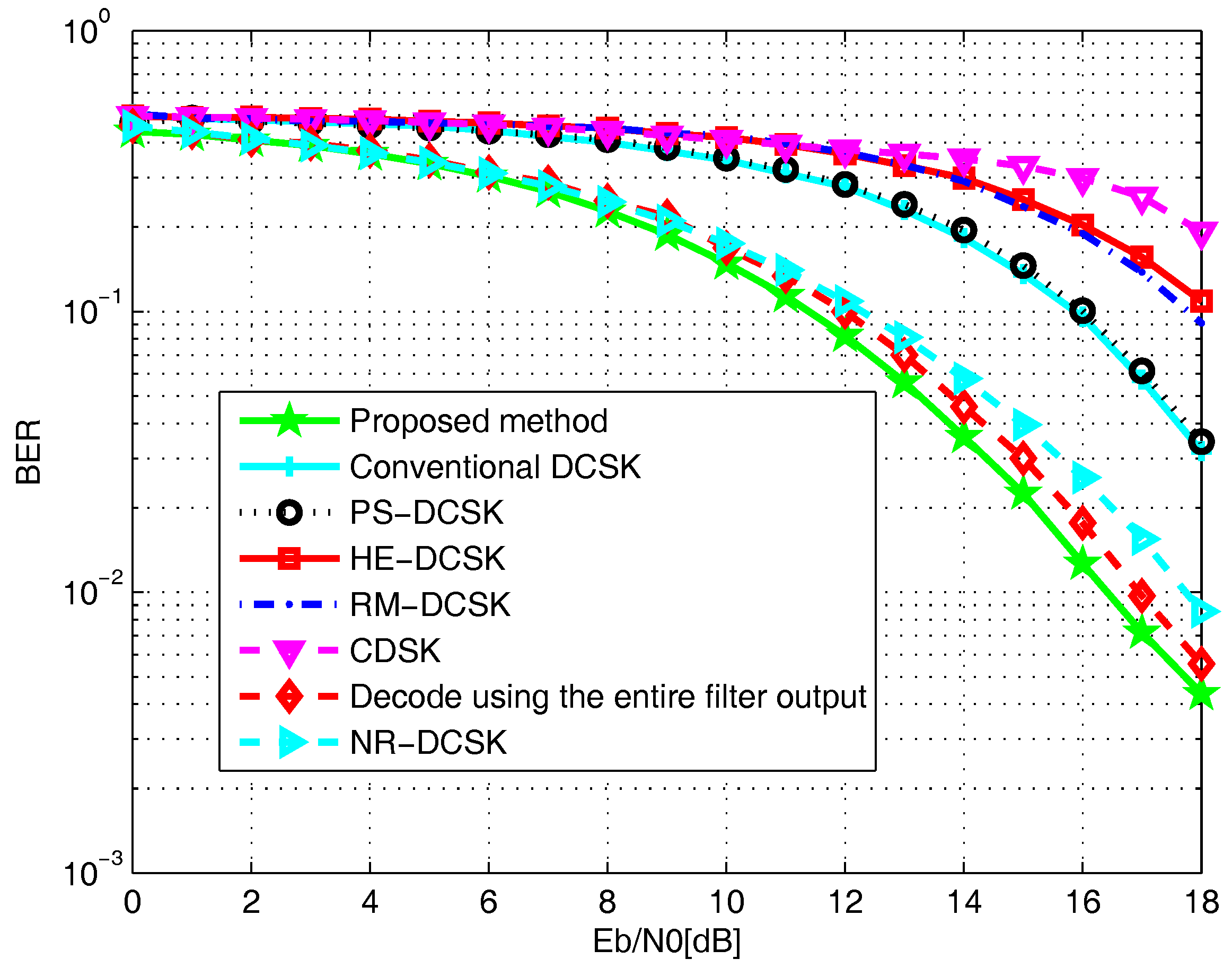Chaos-Based Underwater Communication With Arbitrary Transducers and Bandwidth
Abstract
:1. Introduction
2. DCSK Based on First Order Hybrid System
2.1. The First Order Hybrid Chaotic System
2.2. The Matched Filter for the First Order Hybrid System
2.3. The Proposed DCSK Scheme
3. Simulation Results and Performance Analysis
3.1. The BER performance in the AWGN channel
3.2. The Effect of Spreading Gain on BER
3.3. The BER Performance in the Underwater Acoustic Channel
4. Conclusions
Acknowledgments
Author Contributions
Conflicts of Interest
Appendix A. The Underwater Acoustic Channel
| Parameter Name | Parameter Value |
|---|---|
| sea depth h | 100 m |
| temperature of seawater T | 20 °C |
| transmitter depth | 30 m |
| receiver depth | 80 m |
| propagation distance R | 1000 m |
| seawater sound speed c | 1539 m/s |
| seabed sound speed | 1650 m/s |
| seawater density | 1023 kg/m |
| seabed density | 1500 kg/m |
| seawater salinity S | 35 ppt |
| transducer RMS movement | 0.25 m |
| number of multiple paths | 6 |
| path 1 with surface/bottom reflections s b | 2 1 |
| path 2 with surface/bottom reflections s b | 1 2 |
| path 3 with surface/bottom reflections s b | 3 2 |
| path 4 with surface/bottom reflections s b | 3 4 |
| path 5 with surface/bottom reflections s b | 2 3 |
References
- Climent, S.; Sanchez, A.; Capella, J.V.; Meratnia, N.; Serrano, J.J. Underwater Acoustic Wireless Sensor Networks: Advances and Future Trends in Physical, MAC and Routing Layers. Sensors 2014, 14, 795–833. [Google Scholar] [CrossRef] [PubMed]
- Zhang, L.L.; Huang, J.G.; Tang, C.K.; Song, H.B. Time Reversal Aided Bidirectional OFDMUnderwater Cooperative Communication Algorithm with the Same Frequency Transmission. J. Sens. 2017, 2017, 1–8. [Google Scholar]
- Wei, Z.X.; Song, M.; Yin, G.S.; Song, H.B.; Wang, H.B.; Ma, X.F.; Cheng, A.M.K. Data Access Based on a Guide Map of the Underwater Wireless Sensor Network. Sensors 2017, 17, 2374. [Google Scholar] [CrossRef] [PubMed]
- Diamant, R.; Lampe, L.; Gamroth, E. Bounds for Low Probability of Detection for Underwater Acoustic Communication. IEEE J. Ocean. Eng. 2017, 42, 143–155. [Google Scholar] [CrossRef]
- Wei, Z.X.; Song, M.; Yin, G.S.; Wang, H.B.; Ma, X.F.; Song, H.B. Cross Deployment Networking and Systematic Performance Analysis of Underwater Wireless Sensor Networks. Sensors 2017, 17, 1619. [Google Scholar] [CrossRef] [PubMed]
- Chen, P.; Rong, Y.; Nordholm, S.; He, Z.Q.; Duncan, A.J. Joint Channel Estimation and Impulsive Noise Mitigation in Underwater Acoustic OFDM Communication Systems. IEEE Wirel. Commun. 2017, 16, 6165–6178. [Google Scholar] [CrossRef]
- Ren, H.P.; Baptista, M.S.; Grebogi, C.I. Chaotic Signals in Digital Communications; Eisencraft, M., Attux, R., Suyama, R., Eds.; CRC press: Boca Raton, FA, USA, 2014; pp. 423–437. ISBN 9781466557222. [Google Scholar]
- Paul, A.W. Propagation and Scattering Effects in Underwater Acoustic Communication Channels. IEEE J. Ocean. Eng. 2013, 38, 614–631. [Google Scholar]
- Paul, A.W.; Francois, X.S.; Roald, O.; Trond, J. The Watermark Benchmark for Underwater Acoustic Modulation Schemes. IEEE J. Ocean. Eng. 2017, 42, 1007–1018. [Google Scholar]
- Ren, H.P.; Baptista, M.S.; Grebogi, C. Wireless communication with chaos. Phys. Rev. Lett. 2013, 110, 184101. [Google Scholar] [CrossRef] [PubMed]
- Kaddoum, G. Wireless chaos-based communication systems: A comprehensive survey. IEEE Access 2016, 4, 2621–2648. [Google Scholar] [CrossRef]
- Ren, H.P.; Bai, C.; Liu, J.; Baptista, M.S.; Grebogi, C. Experimental validation of wireless communication with chaos. Chaos 2016, 26, 083117. [Google Scholar] [CrossRef] [PubMed]
- Ren, H.P.; Baptista, M.S.; Grebogi, C. Uncovering missing symbols in communication with filtered chaotic signal. Int. J. Bifurc. Chaos 2012, 22, 1250119. [Google Scholar] [CrossRef]
- Ren, H.P.; Bai, C.; Kong, Q.J.; Baptista, M.S.; Grebogi, C. A chaotic spread spectrum system for underwater acoustic communication. Physica A 2017, 478, 77–92. [Google Scholar] [CrossRef]
- Yao, J.L.; Li, C.; Ren, H.P.; Grebogi, C. Chaos-based wireless communication resisting multipath effects. Phys. Rev. E 2017, 96, 032226. [Google Scholar] [CrossRef] [PubMed]
- Yu, J.; Yao, Y.D. Detection performance of chaotic spreading LPI waveforms. IEEE Wirel. Commun. 2005, 4, 390–396. [Google Scholar]
- Cai, G.F.; Wang, L.; Chen, G.R. Capacity of the non-coherent DCSK system over Rayleigh fading channel. IET Commun. 2016, 10, 2663–2669. [Google Scholar] [CrossRef]
- Ren, H.P.; Bai, C. Secure communication based on spatiotemporal chaos. Chin. Phys. B 2015, 20, 080503. [Google Scholar] [CrossRef]
- Ren, H.P.; Bai, C.; Huang, Z.Z.; Grebogi, C. Secure Communication Based on HyperChaotic Chen System with Time Delay. Int. J. Bifurc. Chaos 2017, 27, 1750076. [Google Scholar] [CrossRef]
- Ren, H.P.; Bai, C.; Tian, K.; Grebogi, C. Dynamics of delay induced composite multi-scroll attractor and its application in encryption. Int. J. Non-Linear Mech. 2017, 94, 334–342. [Google Scholar] [CrossRef]
- Lau, F.C.M.; Tse, C.K.I. Chaos-Based Digital Communication Systems: Operating Principles, Analysis Methods, and Performance Evaluation; Lau, F.C.M., Tse, C.K., Eds.; Springer-Verlag Press: Heidelberg, Germany, 2003; ISBN 9783642056161. [Google Scholar]
- Kolumbán, G.; Vizvári, B.; Schwarz, W.; Abel, A. Differential chaos shift keying: A robust coding for chaos communication. Proc. Int. Workshop Nonlinear Dyn. Electron. Syst. 1996, 96, 87–92. [Google Scholar]
- Nguyen, B.V.; Jung, H.; Kim, K. On the Anti-Jamming Performance of the NR-DCSKSystem. arXiv, 2017; arXiv:1711.05417v1. [Google Scholar]
- Fang, Y.; Han, G.J.; Chen, P.P.; Lau, F.C.M.; Chen, G.R.; Wang, L. A survey on DCSK-Based communication systems and their application to UWB scenarios. IEEE Access 2016, 18, 1804–1837. [Google Scholar] [CrossRef]
- Kaddoum, G.; Soujeri, E.; Arcila, C.; Eshteiwi, K. I-DCSK: An improved noncoherent communication system architecture. IEEE Trans. Circ. Syst. II 2015, 62, 901–905. [Google Scholar] [CrossRef]
- Kaddoum, G.; Tran, H.V.; Kong, L.; Atallah, M. Design of simulations wireless information and power transfer scheme for short reference DCSK communication systems. IEEE Trans. Commun. 2017, 65, 431–443. [Google Scholar]
- Yang, H.; Jiang, G.P. Reference-Modulated DCSK: A novel chaotic communication scheme. IEEE Trans. Circ. Syst. II 2013, 60, 232–236. [Google Scholar] [CrossRef]
- Yang, H.; Jiang, G.P. High-Efficiency differential chaos shift keying scheme for chaos-based noncoherent communication. IEEE Trans. Circ. Syst. II 2012, 59, 312–316. [Google Scholar] [CrossRef]
- Kaddoum, G.; Gagnon, F. Design of a High-Data-Rate differential chaos-shift keying system. IEEE Trans. Circ. Syst. II 2012, 59, 448–452. [Google Scholar] [CrossRef]
- Yang, H.; Jiang, G.P.; Duan, J.Y. Phase-Separated DCSK: ASimple Delay-Component-Free Solution for Chaotic Communications. IEEE Trans. Circ. Syst. II 2014, 61, 967–971. [Google Scholar] [CrossRef]
- Sushchik, M.; Tsimring, L.S.; Volkovskii, A.R. Performance analysis of correlation-based communication schemes utilizing chaos. IEEE Trans. Circ. Syst. I 2000, 47, 1684–1691. [Google Scholar] [CrossRef]
- Corron, N.J.; Cooper, R.M.; Blakely, J.N. Analytically solvable chaotic oscillator based on a first-order filter. Chaos 2016, 26, 023104. [Google Scholar] [CrossRef] [PubMed]
- Corron, N.J.; Blakely, J.N. Chaos in optimal communication waveforms. Proc. R. Soc. A 2015, 471, 20150222. [Google Scholar] [CrossRef]
- Corron, N.J.; Blakely, J.N.; Stahl, M.T. A matched filter for chaos. Chaos 2010, 20, 023123. [Google Scholar] [CrossRef] [PubMed]
- Xu, W.K.; Wang, L.; Kolumbán, G. A novel differential chaos shift keying modulation scheme. Int. J. Bifurcat. Chaos 2011, 21, 799–814. [Google Scholar] [CrossRef]
- Liu, L.D.; Wang, Y.N.; Hou, L.; Feng, X.R. Easy encoding and low bit-error-rate chaos communication system based on reverse-time chaotic oscillator. IET Signal Process. 2017, 11, 869–876. [Google Scholar] [CrossRef]
- Chitre, M. A high-frequency warm shallow water acoustic communications channel model and measurements. Acoust. Soc. Am. 2007, 122, 2580–2586. [Google Scholar] [CrossRef] [PubMed]







© 2018 by the authors. Licensee MDPI, Basel, Switzerland. This article is an open access article distributed under the terms and conditions of the Creative Commons Attribution (CC BY) license (http://creativecommons.org/licenses/by/4.0/).
Share and Cite
Bai, C.; Ren, H.-P.; Grebogi, C.; Baptista, M.S. Chaos-Based Underwater Communication With Arbitrary Transducers and Bandwidth. Appl. Sci. 2018, 8, 162. https://doi.org/10.3390/app8020162
Bai C, Ren H-P, Grebogi C, Baptista MS. Chaos-Based Underwater Communication With Arbitrary Transducers and Bandwidth. Applied Sciences. 2018; 8(2):162. https://doi.org/10.3390/app8020162
Chicago/Turabian StyleBai, Chao, Hai-Peng Ren, Celso Grebogi, and Murilo S. Baptista. 2018. "Chaos-Based Underwater Communication With Arbitrary Transducers and Bandwidth" Applied Sciences 8, no. 2: 162. https://doi.org/10.3390/app8020162




